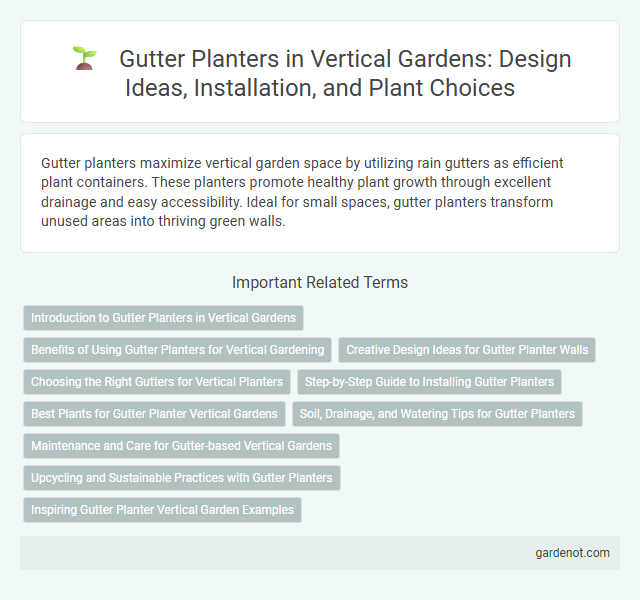Gutter planters maximize vertical garden space by utilizing rain gutters as efficient plant containers. These planters promote healthy plant growth through excellent drainage and easy accessibility. Ideal for small spaces, gutter planters transform unused areas into thriving green walls.
Introduction to Gutter Planters in Vertical Gardens
Gutter planters are innovative solutions designed to maximize vertical gardening space by utilizing reclaimed or new gutters as planting beds. These long, narrow containers provide excellent drainage and are ideal for growing herbs, succulents, and small flowers in compact areas. Their modular design allows for easy installation on walls or fences, creating a visually appealing and efficient vertical garden system.
Benefits of Using Gutter Planters for Vertical Gardening
Gutter planters maximize vertical gardening space by utilizing narrow, horizontal channels ideal for growing herbs, succulents, and small vegetables. Their efficient water drainage reduces root rot while promoting healthy plant growth, making them perfect for urban balconies and limited outdoor areas. Easy installation and modular design offer flexibility in creating customized green walls, enhancing both aesthetics and air purification.
Creative Design Ideas for Gutter Planter Walls
Gutter planter walls transform narrow spaces into lush vertical gardens by creatively stacking repurposed rain gutters filled with vibrant herbs, succulents, or flowering plants. Innovative designs incorporate staggered or linear arrangements, maximizing sunlight exposure and optimizing drainage while adding a modern aesthetic to patios or balconies. Integrating drip irrigation systems enhances plant health and reduces maintenance, making gutter planter walls both functional and visually captivating.
Choosing the Right Gutters for Vertical Planters
Selecting the appropriate gutters for vertical planters requires considering materials such as PVC, aluminum, or galvanized steel for durability and rust resistance. Gutters with a depth of 3 to 5 inches and a width of at least 4 inches provide ample space for root growth and moisture retention. Ensure proper drainage holes are included to prevent waterlogging and promote healthy plant development in vertical garden installations.
Step-by-Step Guide to Installing Gutter Planters
Installing gutter planters begins by selecting sturdy vinyl or aluminum gutters, typically 5 inches wide, to ensure durability and adequate soil space. Secure the gutters on a vertical surface using corrosion-resistant brackets spaced every 12-18 inches for optimal support, then drill drainage holes to prevent waterlogging. Fill the gutters with a lightweight, well-draining potting mix before planting shallow-rooted herbs or succulents, which thrive best in this vertical garden setup.
Best Plants for Gutter Planter Vertical Gardens
Best plants for gutter planter vertical gardens include herbs like thyme, oregano, and chives due to their shallow roots and compact growth. Succulents such as sedum and hens-and-chicks thrive in narrow spaces and require minimal water, making them ideal for gutters. Small flowering plants like pansies and petunias add color while adapting well to the limited soil depth.
Soil, Drainage, and Watering Tips for Gutter Planters
Gutter planters require well-draining soil mixtures to prevent waterlogging and root rot, typically using a blend of potting soil, compost, and perlite for optimal aeration. Ensuring proper drainage holes are drilled into the gutter sections allows excess water to escape, maintaining healthy root environments. Regular, moderate watering is essential to keep the soil consistently moist but not saturated, with drip irrigation systems recommended for precise moisture control in vertical setups.
Maintenance and Care for Gutter-based Vertical Gardens
Maintaining gutter planters in vertical gardens requires regular inspection for clogs and debris to ensure proper water drainage and prevent root rot. Pruning plants and removing dead foliage promote healthy growth and avoid overcrowding in narrow gutter spaces. Applying balanced fertilizers and monitoring moisture levels help sustain plant vitality in these compact vertical systems.
Upcycling and Sustainable Practices with Gutter Planters
Gutter planters transform discarded rain gutters into functional vertical garden beds, promoting upcycling by repurposing materials that would otherwise contribute to landfill waste. This sustainable practice reduces the need for new plastic or metal containers, lowering environmental impact while maximizing urban green spaces. Their efficient design supports water retention and plant growth, making gutter planters an eco-friendly solution for home gardeners and urban farming enthusiasts.
Inspiring Gutter Planter Vertical Garden Examples
Gutter planter vertical gardens transform narrow spaces into lush, vibrant green walls by repurposing rain gutters as planting channels. Examples such as urban balconies or small patios showcase how these modular systems maximize greenery with minimal footprint, supporting herbs, succulents, or trailing plants. Innovative designs integrate drip irrigation and lightweight soil mixes, enhancing growth while maintaining easy installation and maintenance.
Gutter planter Infographic

 gardenot.com
gardenot.com